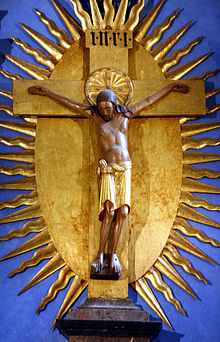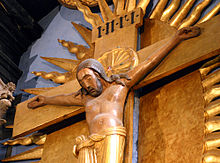- Gero Cross
-
The Gero Cross or Gero Crucifix ("Gero-Kreuz" in German), of around 965–970, is the oldest large sculpture of the crucified Christ north of the Alps, and has always been displayed in Cologne Cathedral in Germany. It was commissioned by Gero, Archbishop of Cologne, who died in 976, thus providing a terminus ante quem for the work. It is carved in oak, and painted and partially gilded – both have been renewed. The halo and cross-pieces are original, but the Baroque surround was added in 1683. The figure is 187 cm high, and the span of the arms is 165 cm.[1]
The figure appears to be the earliest, and finest, of a number of life-size German wood sculpted crucifixions that appeared in the late Ottonian or early Romanesque period, later spreading to much of Europe. Additionally it appears to be the oldest Western depiction of a dead Christ on the cross;[2] in most earlier depictions Christ holds his head erect and looks straight ahead, or in some Carolingian examples looks down at the Virgin at the foot of the cross.[3] The slumped head, and the twisted body, which arises as the hands are nailed to the cross at different heights, are found neither in Carolingian nor Byzantine art, and were to be slow to influence Western depictions, although the long hair spread over the shoulders is found in some Carolingian works.[4] In crucifixions of the Gothic period a still more slumped and curved figure of Christ, with knees bent sideways, was to become the standard depiction.
Earlier large figures of Christ on the Cross appear to have been in metal, or metal on a wooden core; there was said to be one in Charlemagne's Palatine Chapel in Aachen, and the Golden Madonna of Essen is an example of this type.[5] The development of a tradition of free-standing monumental sculpture was a crucial development in Western art; in Byzantine art such images had been forbidden by the Second Council of Nicaea in 787, and probably had been extremely rare before that.
The cross hangs in its own chapel near the sacristy in Cologne Cathedral – now a different, Gothic, building from the one it was made for. The Chronicon of Thietmar of Merseburg, written 1012-1018, said that it was originally displayed above Gero's grave; though no one is now sure where that was located in the old church, most scholars place it somewhere on the central axis of the nave,[6] in which case it may have been at the chancel arch, the usual location of later roods or large crucifixes. It has long been celebrated and visited by pilgrims. Until the 1920s, despite local tradition, and the reference in Thietmar's chronicle,[7] associating it with Gero, it was thought to be at least a century later in date, and it is indeed innovative for its date.[4] The dating was confirmed by dendrochronology in 1976, ending the controversy.[2] Contrary to long-held tradition, the studies in 1976 revealed that there is no space in the back of the head to place relics.[8]
According to the Luccan local histories, the Holy Face of Lucca in Italy is considerably older, though that sculpture had to be recreated in the Gothic period after being nibbled away by pilgrims, which makes this claim difficult to verify by art historians.[9]
A replica of the crucifix hangs in the St. Alphonsus Chapel located in the Alphonse J. Schwartze Memorial Catholic Center in Jefferson City, Missouri.
Notes
- ^ Schiller, pp. 140–142
- ^ a b Lauer
- ^ Schiller, 142 lists examples
- ^ a b Schiller, 141–2
- ^ Schiller, 140
- ^ Kaspersen & Thunø, pp. 46–7
- ^ the passage, quoted in Kaspersen & Thunø, pp.45–6
- ^ Decorating the Lord's Table: On the Dynamics Between Image and Altar in the Middle Ages, Søren Kaspersen, Erik Thunø, p.59, note 18, 2006, Museum Tusculanum Press, ISBN 8763501333
- ^ Schiller, 144
References
- Lauer, Rolf, in Legner, Anton (ed). Ornamenta Ecclesiae, Kunst und Künstler der Romanik., III, p. 214 (E17), Catalogue of an exhibition in the Schnütgen Museum, Köln, 1985. 3 vols.
- G Schiller, Iconography of Christian Art, Vol. II,1972 (English trans from German), Lund Humphries, London, pp. 140–142, ISBN 853313245
External links
Categories:- Religion in Cologne
- Culture in Cologne
- History of Cologne
- Medieval European sculptures
- Statues of Jesus
- German sculpture
- Individual crosses and crucifixes
Wikimedia Foundation. 2010.


